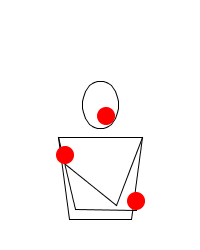Burke's Barrage

Burke's Barrage is a toss juggling pattern named after its inventor Ken Burke.[1] It is quite popular among jugglers due to the impressive arm moves, but it's not so hard to master, compared to the Rubenstein's Revenge for example.[2]
The pattern is based on the siteswap sequence 423. This sequence represents the height of the three basic throws in the pattern. The 3 represents a ball thrown at the typical height of a 3-ball cascade. The 4 represents a ball thrown at the height of a four-ball fountain. This ball stays on one side of the body while in the air and is thrown and caught by the same hand. Lastly, the 2 does not represent a throw, but circular motion of the hand carrying a ball through the pattern.
The idea is to throw the 4, then the 3, and when you catch the first ball you throw you make a big circle around the ball on the 3. Each 4 should be caught with a claw catch. In other words, each 4 throw is snatched with the palm facing down. The palm is turned to face up as the hand rotates around in its circle motion.
When Ken Burke himself juggles it, the circular carry passes between the 3 and the other 4, rather than around both of them.
It has nothing to do with Luke Burrage, although he invented a juggling trick quite similar to Burke's Barrage, which he named Burke's Burrage. It is the same as a Burke's Barrage, but instead of making a big circle around the ball on the 3, you just put it apart on the side, which makes a more geometrical impression.
References
- ↑ Russ Kaufman (Fall 1986). "Festivals - Fireworks in Baltimore". Juggler's World (International Jugglers' Association) 38 (3). Retrieved January 13, 2011.
- ↑ Gillson, George (1990). Beyond the Cascade, . Cascade Books: Seattle Washington.
| |||||||||||||||||||
